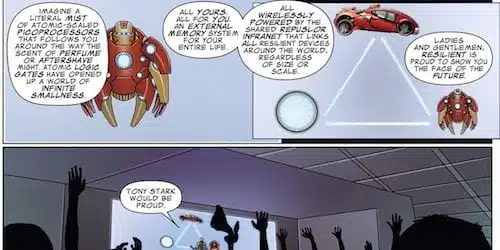
I take another look at the last page of “The Demolished Man”, part one of “The Future”, the most recent storyarc of Matt Fraction and Salvador Larroca’s Invincible Iron Man. One last look at that page and I honestly want to cry. It’s those padlocks, you see. Those huge, awful, Da-Vinci-esque-in-their-ambition padlocks. The vest that the Mandarin and his goons shoved Tony Stark into really is something different. It is a tangible piece of the future. Much like the windshield of any high-end sedan, or the tech found in the screen of the laptop I’m writing on right now.
That vest the Mandarin and his thugs shackled Tony in must have all sorts of future-tech electronics secreted inside. Electronics to countermand whatever protocols trigger the repulsor array implanted in Tony’s chest. The same array that keeps him alive. And yet that vest, like the windshield or the computer screen, seems plain and ordinary on the outside.
But those padlocks.
Those massive, interminable padlocks, bedraggled by history. Those padlocks that appear as props from the coming Game of Thrones season seven (the season where it’s nothing but torture porn)… There’s nothing future-tech about those damnable, arcane things. Nothing at all. And it makes me want to shed a tear, realizing exactly the threat that Tony faces in “The Future”. The threat of a technologically sophisticated man of the twenty-first century, who will simply bowdlerize that technology, rendered it as something in the service of medieval thinking.
This is the true threat the Mandarin represents. And these are my tears.
But if there’re tears to be had here, and I really am on the verge, the beauty of one lone image betraying the true nature of the Mandarin’s threat is just one of many reasons for them. Another reason is Rex Mantooth. Who would have thought all those many years on the writer of the quirky, hyper-intelligent gorilla Rex Mantooth, a gorilla who also enters the world as a kind of James Bond figure battling (as he does) against Oprah Winfrey’s lesbian army and super-scientist-turned-zombie Stephen Hawking, would turn out to be the generationally definitive writer in the way he has?
Yet another is Invincible Iron Man itself.
This new series of to feature Iron Man was coincided with the release of the first Iron Man movie in 2008, the one that blew everyone away. The opening arc, “The Five Nightmares” detailed the fear that resided in the heart of Ton Stark, that he was already yesterday’s man, that he was already obsolete. And all of those fierce and terrible energies he relied on, those same energies that helped him manifest the technological future, were the only forces preventing him from a life-taking event.
Fraction relied heavily on Iron-lore to pull off this arc. He wrote Tony as squaring off against Zeke Stane, the son of Obadiah Stane, probably the most vicious opponent Tony ever faced. Rather than come for Iron Man, Stane the elder came directly for Stark Industries. And he succeeded while Tony mired in a bottle after bottle of scotch. Fraction’s exploitation of the full scope of the lead character’s history become a touchstone for the series. Even as new events rocked the Earth-616 (Marvel’s fictional universe), even as “Dark Reign” unfolded where villains replaced heroes in the eyes of a beguiled public, or as the returning heroes of the new Heroic Age fought to pull Tony out from a persistent vegetative state, or as Tony founded a new company, Stark Resilient, Fraction leveraged the lead’s history.
To wit, recent arc “Demon” replays, point-for-point, the ending of the classic David Micheline-John Romita Iron Man story, Demon in a Bottle. The villains have won, and Tony and a close friend drive off into the proverbial LA sunset. The emotional impact is exactly the same. This same trend can be seen playing out in “What it was Like, What Happened, and What it’s Like Now”, a story that wrestles with the true emotional stressors that drive Tony to alcoholism. Iron Man, Tony Stark, isn’t simply inventing the future, seems to be Fraction’s underlying message here, Tony’s also reinventing the past and it’s vicious but also loving hold on him.
The thing about “The Future” then is this. It should come as no surprise that events play out in the actual future of Earth-616. Some six months to be exact, but six months as Marvel EIC Joe Quesada reminded us recently, is about five years of real-world time. But even more so, it should come as no surprise that Tony has been returned right to the very beginning, to his own origin story — working for a terrorist, forced into building weapons, and in the process of dying unless he take drastic steps to extricate himself.
With a single issue, Matt Fraction has underlined the incredible value of having who has a unique vision for the character they’re working on. And seeing Iron Man co-imprisoned with his former nemesis Zeke Stane, himself now mostly brain-dead, adds shades of moral complexity that a generation ago, no one would have anticipated encountering in a comicbook.
Fraction doesn’t surpass all expectations with “The Demolished Man”, he simply educates us that when it comes to “The Future”, expectations are more or less meaningless.
